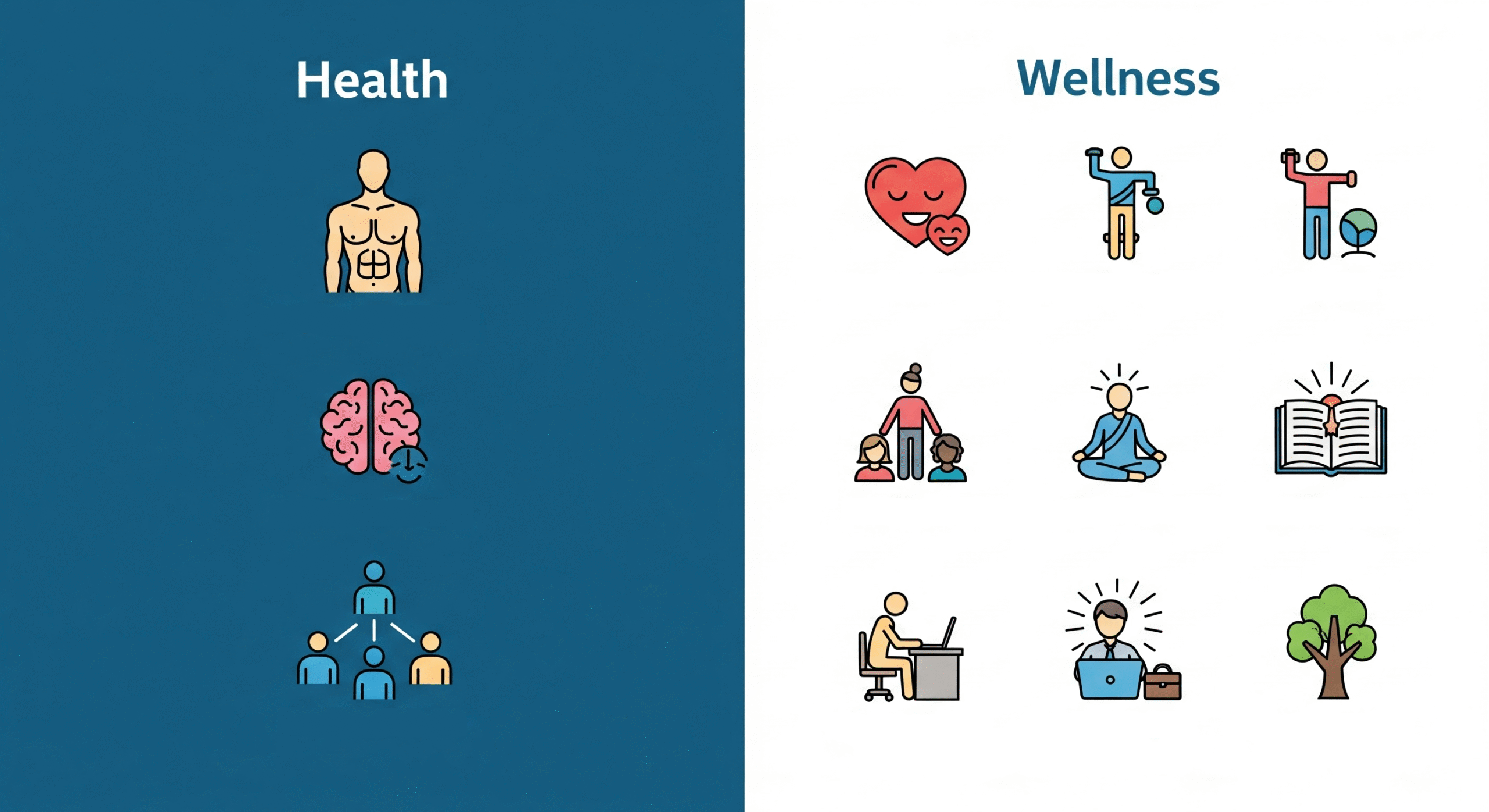“Health” and “wellness” are often used interchangeably. After all, if you’re not sick, you must be healthy—right? Well, not exactly. While they’re closely related, health and wellness are not the same thing. Understanding the difference between them is the key to living a more fulfilling, balanced, and proactive life.
According to the World Health Organization, nearly 50% of the global population suffers from a mental disorder at some point in their lives. That’s a staggering reminder that health isn’t just physical.
What Is Health?
Health is often defined in terms of the physical body—specifically, the absence of disease or injury. According to the World Health Organization (WHO), health is “a state of complete physical, mental, and social well-being—not merely the absence of disease or infirmity.”
Here’s what health typically includes:
- Physical well-being: A strong immune system, healthy vital signs, and no chronic illnesses.
- Medical status: Measurable indicators like blood pressure, cholesterol levels, and organ function.
- Genetic and environmental factors: Conditions you’re born with or that arise due to your surroundings.
Examples of being healthy:
- Maintaining a normal blood sugar level
- Recovering from a cold or surgery
- Taking medication to manage high blood pressure
But here’s the catch: being healthy doesn’t always mean you’re truly well.ving with a stable condition, not thriving.
What Is Wellness?
Wellness, on the other hand, is a more holistic, proactive approach to life. It’s not just about avoiding illness—wellness is about thriving. It’s a conscious, ongoing journey of growth that encompasses every area of your life.
Wellness is often broken down into multiple dimensions, including:
- Emotional – Understanding and managing your emotions
- Physical – Taking care of your body proactively
- Social – Building strong, healthy relationships
- Spiritual – Connecting with your values or purpose
- Intellectual – Challenging your mind and learning new things
- Occupational – Finding meaning and satisfaction in your work
- Environmental – Living in harmony with your surroundings
Examples of practicing wellness:
- Taking a break from screens to connect with nature.
- Meditating for 10 minutes a day
- Prioritizing work-life balance
Key Differences: Health vs Wellness
Reactive vs Proactive
- Health is often about treatment. You go to the doctor when something is wrong.
- Wellness is about prevention. You adopt habits to keep problems from arising in the first place.
Medical vs Holistic
- Health tends to focus on the body.
- Wellness covers body, mind, and soul—how you feel, think, and connect.
State vs Ongoing Process
- Health can be temporary. You might be healthy today and sick tomorrow.
- Wellness is an active, lifelong pursuit that evolves with you.
“Health is a state of body. Wellness is a state of being.” — J. Stanford
Why Understanding the Difference Matters
When you only focus on health, you might miss out on the bigger picture.
Understanding the difference allows you to:
- Take control of your life, not just your symptoms.
- Build resilience emotionally and mentally, not just physically.
- Improve your quality of life—not just the length of it.
In 2021, over 22% of Americans had a mental illness, yet 33–54% received no treatment. That proves wellness gaps are widespread.
How to Improve Both Your Health and Wellness
You don’t have to choose between health and wellness. You can—and should—prioritize both.
Here’s how:
Nutrition & Physical Activity
- Eat a balanced, colorful diet.
- Move your body in a way that feels good—walk, dance, lift, or stretch.
Stress Management
- Practice mindfulness or meditation.
- Take time to disconnect from digital noise.
Preventive Care
- Get regular check-ups and screenings.
- Stay on top of vaccines and health records.
Build Positive Habits
- Sleep 7–8 hours a night.
- Practice gratitude daily.
- Limit alcohol, sugar, and screen time.
Small steps, done consistently, lead to big results.
Common Myths Debunked
- “If I’m not sick, I’m well.”→ Illness absence doesn’t mean emotional or mental peace.
- “Health = doctor visits only.”→ Wellness is shaped daily—in thoughts, habits, and interactions.
- “Wellness is just a trend.”→ Dunn’s model shows wellness is a 70-year evolving paradigm, not a fad.
Conclusion
Health and wellness are deeply linked, but not the same. Health focuses on your physical state—wellness nurtures your entire self. Don’t just avoid illness—strive to thrive. Choose one small wellness habit this week—whether it’s movement, meditation, or a medical check—in order to elevate both your health and happiness.
